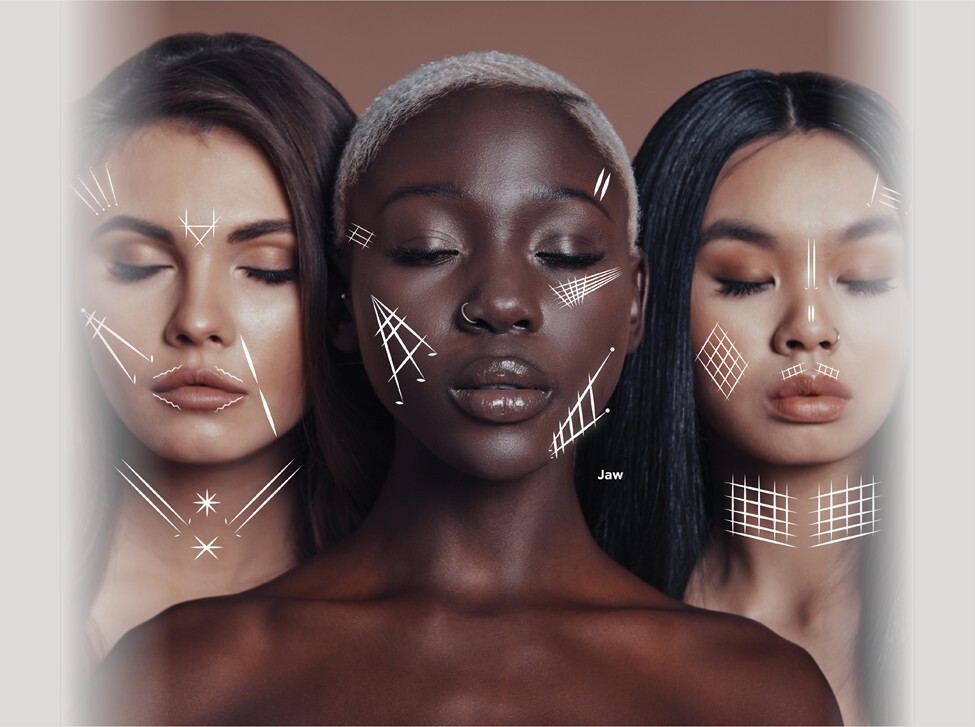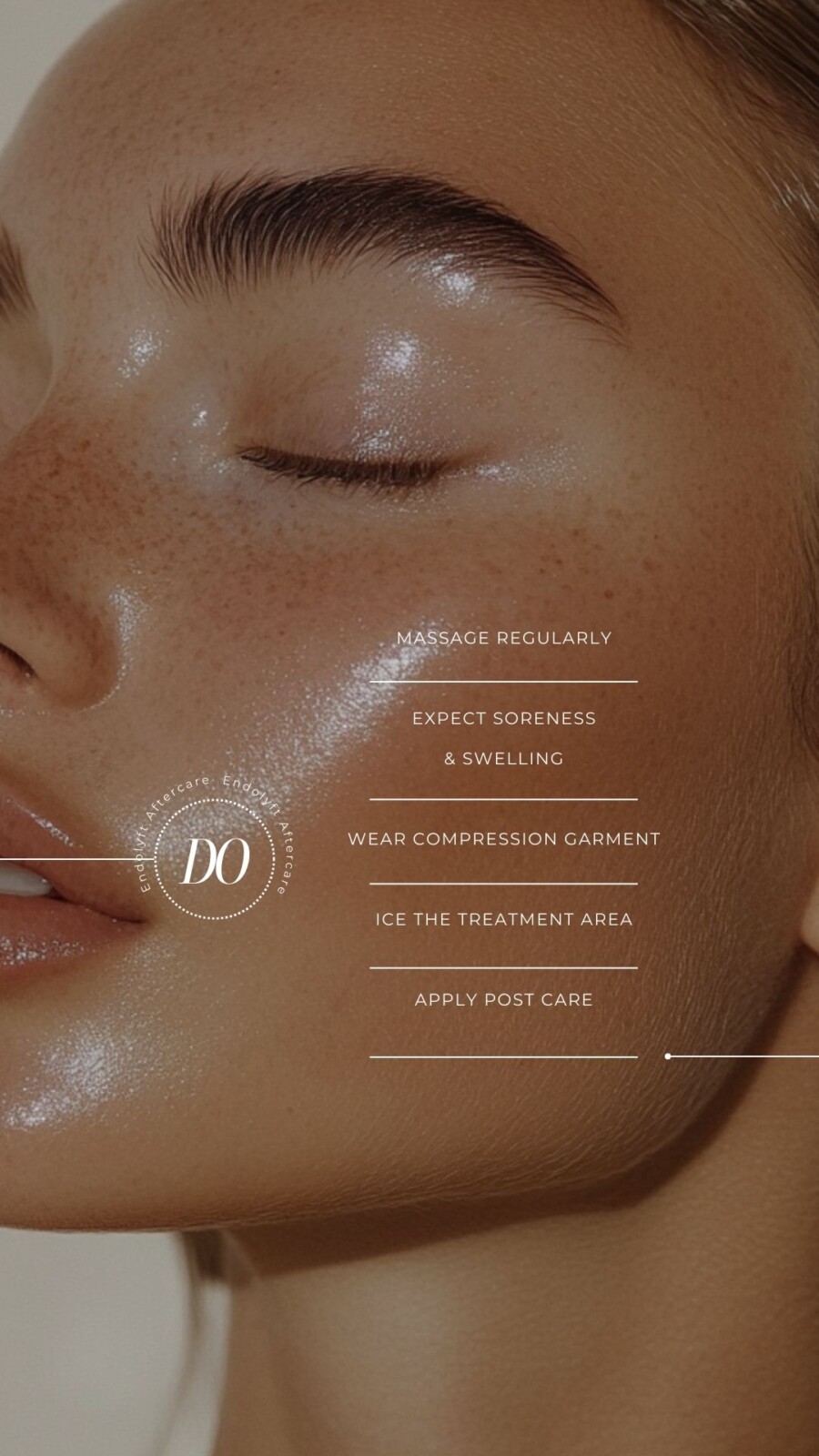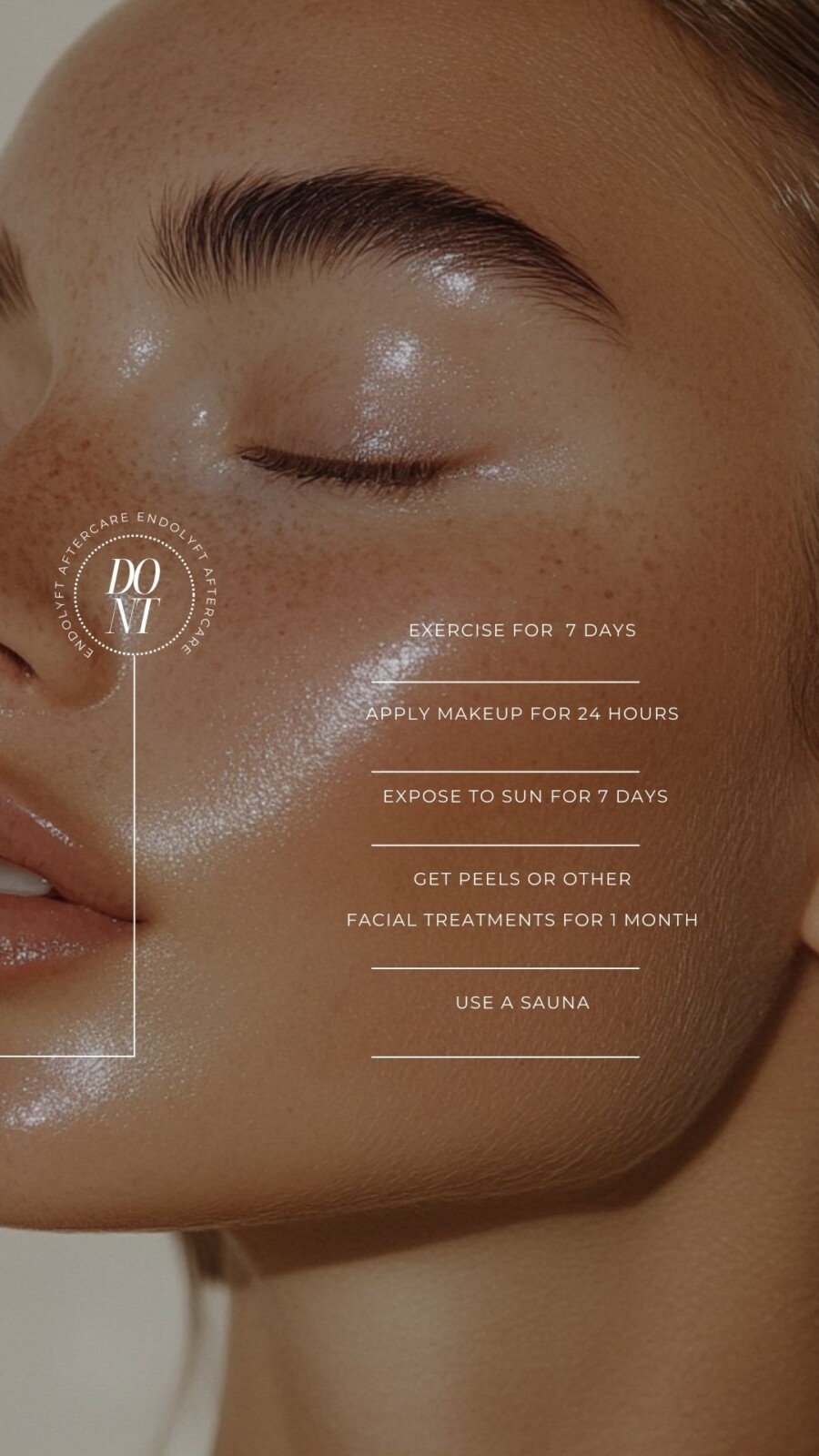- What is Endolyft?
- What Should I expect?
- Pre-treatment instructions
- Contraindications
- Post-treatment instructions
- Where can Endolyft be used?
The Endolyft procedure treatment day can vary. However, below is a typically appointment:
- Preparation: The treatment area will be cleansed, and a topical anesthetic may be applied to ensure comfort.
- Procedure: Ultra-thin micro-optical fibers are inserted beneath the skin. These fibers deliver laser energy to promote skin tightening and may also be programmed to melt fat. The process is generally well-tolerated, with most patients experiencing only a warming sensation.
- Duration: The procedure typically lasts between 1 hour to 3 hours, depending on the size and number of areas being treated.
- Post-Treatment: Mild redness or swelling may occur but usually subsides within a few days. You can return to your normal activities almost immediately. See Post Care for more information.
Results are often visible right after the first session and continue to improve over the following months as collagen production increases.
The Endolyft procedure treatment day can vary. However, below is a typically appointment:
- Preparation: The treatment area will be cleansed, and a topical anesthetic may be applied to ensure comfort.
- Procedure: Ultra-thin micro-optical fibers are inserted beneath the skin. These fibers deliver laser energy to promote skin tightening and may also be programmed to melt fat. The process is generally well-tolerated, with most patients experiencing only a warming sensation.
- Duration: The procedure typically lasts between 1 hour to 3 hours, depending on the size and number of areas being treated.
- Post-Treatment: Mild redness or swelling may occur but usually subsides within a few days. You can return to your normal activities almost immediately. See Post Care for more information.
Results are often visible right after the first session and continue to improve over the following months as collagen production increases.
Proper preparation begins well before your treatment date. During this period, you must discontinue:
- Medications: Avoid taking blood thinners, aspirin, ibuprofen, Advil, Aleve, (NSAIDs) 1–2 weeks before treatment. If you take blood thinners, you should consult with your doctor before stopping them.
- Anti-coagulation Medications: If you are currently taking anti-coagulation medications such as (Warfarin, Coumadin, Heparin, Lovenox, Enoxaparin, Lepirudin, Refludan, Ticlopidine Ticlid, Clopidogrel, Plavix, Tirofiban, Aggrastat, Eptifibatide, Integrilin), discuss the use of these medications prior to your treatment.
- Supplements: Avoid ginkgo biloba, garlic, flax oil, cod liver oil, vitamin A, oral vitamin E, fatty acids, St. John’s Wort, and niacin supplements 14 days before your treatment. These supplements thin the blood and increase the risk for bleeding/bruising.
- Alcohol: Avoid alcohol 1 week before treatment.
- Smoking: Please do not smoke 2 weeks before and after treatment.
- Skincare: Avoid topical skincare products that contain glycolic acid, salicylic acid, or retinoic acids for 1 week before treatment.
- Skin conditions: Avoid treatment if you have a skin infection at or around the treatment area, active acne, or cold sore in the treatment area.
- Sun Protection: Sunscreen is recommended to protect your skin before your appointment for at least 2 weeks.
- Other procedures: Avoid surgical procedures and routine procedures like dental work for 2 weeks before treatment.
- Pregnancy and breastfeeding: Do not receive treatment if you are pregnant or breastfeeding.
- Allergies: Do not receive treatment if you are allergic to any of the ingredients used during the procedure or numbing medications.
- Neurological disorders: Do not receive treatment if you have any neurological disorders.
- Start Arnica tablet: Arnica 200ck sublingual may be used as indicated on bottle 2-3 days prior to reduce risk of bruising and swelling.
- Schedule: Schedule the procedure at least three weeks before a big event.
- Cleanliness: Arrive for the procedure with a clean face and without makeup.
- For Men: Shave your face the day before the treatment; the treatment area should be hair-free
- Neuromodulators: Avoid Botox for a minimum of 14 days before treatment
- Dermal Fillers: Do not use dermal fillers in the treatment area for a minimum of 14 days before the procedure
Before receiving this laser assisted treatment, please inform your laser technician about your medical history including conditions you have. This includes if you had or have planned surgery, or a cosmetic treatment done on your face, neck, chin, or body.
- Prescriptions: Tell your laser technician about any medicine you take including prescriptions, over the counter medicines, vitamins and herbal supplements.
- Pregnancy: This treatment is not recommended for pregnant women. While the procedure is minimally invasive, pregnancy is a time when many treatments are avoided to ensure the safety of both the mother and the baby. Factors like hormonal changes and increased sensitivity during pregnancy can also affect how the body responds to such treatments.
- Open wounds/abrasions: Open wounds are a contraindication because the procedure involves the use of a laser fiber inserted beneath the skin. Open wounds increase the risk of infection and complications during and after the treatment. Additionally, the presence of open wounds can interfere with the healing process and may lead to undesirable outcomes.
- Thrombosis: This is because thrombosis involves blood clots that can obstruct blood flow, and the procedure’s use of laser energy and its minimally invasive nature could increase the risk of complications in individuals with this condition. Additionally, patients with thrombosis are often on anticoagulant medications, which can further elevate the risk of bleeding or other adverse effects during the procedure.
- Anticoagulant Medications/Blood Thinning Medications: Patients taking blood thinning medications like anticoagulants, should avoid this treatment due to increased risk of bleeding.
- Liver Dysfunction: The liver plays a crucial role in metabolizing medications and managing the body’s response to treatments. Impaired liver function can affect the body’s ability to heal and process any medications used during the procedure, increasing the risk of adverse effects.
- Kidney Dysfunction: The kidneys are essential for filtering waste and maintaining fluid balance. Kidney dysfunction can lead to complications, such as fluid retention or difficulty in managing any potential side effects from the procedure.
- Skin Cancer: The procedure involves the use of laser energy, which could potentially aggravate cancerous or precancerous lesions. Additionally, the presence of skin cancer indicates underlying skin health concerns that need to be addressed before considering any aesthetic treatments. should not undergo this procedure.
- Cancer: Generally this treatment is not recommended for individuals with cancer, especially active or untreated cancer. The procedure involves the use of laser energy, which could potentially interfere with cancerous tissues or complicate the healing process. Additionally, cancer patients could be at high risk if they have a compromised immune system or may be undergoing treatments like chemotherapy, which can increase the risk of complications.
- Allergies to anesthetics: Patients with known allergies to local anesthetics should avoid the procedure.
- Vascular disorders: These can interfere with the healing process.
- Presence of biopolymers: If there are biopolymers in the treatment area, the procedure is not recommended.
- Abnormal scaring history: Patients prone to keloids or hypertrophic scars should be cautious. If you have a history of abnormal scarring such as keloids, you may experience complications.
- Active skin infections or lesions: Those with active skin conditions, such as psoriasis or eczema, in the treatment area must have the issue resolved before undergoing the treatment.
- Autoimmune diseases: Decompensated autoimmune conditions are contraindication.
- Neurological Conditions: Conditions such as epilepsy or other seizure disorders may need to be assessed, as the procedure involves light energy that could theoretically trigger a reaction.
- Metal Implants or Devices: If the patient has metal implants in the treatment area (e.g., pacemakers, metal pins, or plates), this might affect the safety or efficacy of the procedure.
- Photosensitivity Disorders or Medications: Patients with conditions like lupus or those taking medications that cause photosensitivity (e.g., certain antibiotics, isotretinoin) may be at higher risk of adverse reactions to laser treatments.
- Severe Cardiovascular Conditions: Patients with unstable or severe heart conditions should be evaluated due to the possible stress of the procedure on their body.
- Uncontrolled Diabetes: Poorly managed diabetes can impair wound healing and increase the risk of infection, making the procedure unsafe.
- Chronic Inflammatory Skin Disorders: Chronic inflammatory conditions, such as rosacea or severe dermatitis, might worsen with the procedure and should be noted.
- Recent Cosmetic Procedures: If the patient has recently undergone certain treatments like neuromodulators, fillers injected, chemical peels, laser resurfacing, or other procedures in the same area, their skin may be too sensitive for this treatment at that time.
- Psychological Conditions or Unrealistic Expectations: Patients with untreated severe psychological conditions, or those with unrealistic expectations of the outcome, might require additional evaluation before proceeding.
After your Endolyft procedure, it is recommended that the treated area be avoided and not washed for 24 hours. After the 24 hours you may follow the following skin routine:
- Wash skin with the Gentle Cream Cleanser with cool water. Avoid using towels or abrasive scrubbing cleansing cloths. Pat dry once rinsed with water.
- Wipe the entry sites with alcohol and cover with a bandage until fully healed.
- Tone skin with the Calming Flower Mist.
- Apply post care safe serums after toning options include: Phyto Calm Aloe Drops, EGF Drops, or Antistress CBD.
- Additional post care safe serums include the HA Revive Hydrator Dops or Daily Hydration Drops.
- Moisturize with the Phyto Calm Hydrator or Vita E Moisturizing Cream.
- Apply SPF of 30 or higher 15 minutes before sun exposure and reapply as needed.
Additional advisories:
Compression: Your Endolyft face strap will help to reduce the amount of swelling that develops after treatment.
- DAY 1-3. Apply the face strap as much as possible day and night.
- DAY 4-10. Apply the face strap in the evening and overnight.
- WEEK Day 11 – Week 6: Wear compression strap at night for best results.
Starting Lymphatic Drainage Massage: This helps to mechanically drain residual fluid in the treated tissue and speeds up healing from swelling. Endolyft aftercare.
- DAY 10-20. For 15 minutes per night, apply backwards and downwards massage to the mid-lower face, under chin and neck using the post care products.
Makeup: Avoid makeup for 24 hours.
Keep Your Head Elevated: Sleep with your head on pillows for the first 3 to 5 nights. This position helps reduce swelling and prevents unnecessary pressure on the treated areas.
Cooling and Comfort: Apply a cold compress to the treated area to reduce swelling and discomfort.
Avoid Strenuous Activities: Refrain from vigorous exercise, heavy lifting, or any activity that significantly increases your heart rate or blood pressure for at least 1 week. High-intensity activities can increase swelling and affect healing.
Post Care Products: We have hand-picked creams for you to help accelerate the skin recovery process.
Anica: Arnicare Gel helps to reduce bruising. Apply twice per day for the first week. Pair with Arnica usblingual for faster healing.
Be Gentle with Your Skin: When applying skin routine or doing your lymphatic massage, keep the touch light for at least three weeks. Use gentle motions when cleansing your face or applying products. This care is crucial to allow the tissues to integrate properly without shifting and to maintain stimulating collagen production.
Stay Cool: Avoid exposure to high-heat environments such as saunas, steam rooms, or sunbathing for 7 days. Excessive heat can cause swelling and may delay healing.
Attend Follow-Up Appointments: Keep all scheduled follow-up appointments. These check-ins are vital for assessing the healing process and ensuring the healing as expected. If you notice any unusual symptoms or have concerns, contact us immediately.
Protect Your Skin: It is recommended that you use the post care routine for 7 – 14 days as outline above.
Stay Hydrated and Maintain a Healthy Diet: Maintaining proper hydration and following a balanced diet rich in vitamins and minerals significantly contributes to the longevity of your results, as these practices can boost your skin’s natural healing abilities and support collagen production.
Sun exposure: Stay out of direct sunlight for 1 week or until swelling subsides. Always use SPF 50 when outdoors.
Acid-based cleanser or products: Refrain from using acid-based skincare products, such as those containing AHAs or BHAs, for 1 week after treatment. Do not use topical retinol or Vitamin A creams for at least 1 week after treatment. Facial treatments and chemical peels: Refrain from having any facial treatments or chemical peels for 2 weeks following your Endolyft treatment.
This treatment can be customized to treat face and body for skin tightening and/or fat reduction. Popular areas include:
- Cheeks
- Jawline
- Jowls
- Under chin
- Upper neck
- Décolletage
- Under eye often referred to as ‘malar bags’
- Upper eye lid
- Abdomen
- Waist
- Thighs
- Knees
- Upper arms


